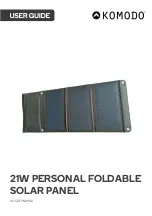
3
Cable protection
We recommend securing the cables to the mounting system
using UV resistant cable ties. Protect exposed cables from
damage (for example by laying them in plastic pipes). Avoid
direct exposure to sunlight. A bending radius of minimum 35
mm must be maintained.
SolarWorld AG recommends laying all electrical cables and
connections in compliance with national regulations for
electrical instal-lations. Bypass diodes are factory installed.
Opening the junction box
DANGER!
Danger of death from electric shock
▹ In order to ensure protection against electrical shock the
junction box MUST be disconnected from all external
power sources while installing the cables! DO NOT
CONNECT UNDER LOAD!!!
To open, use a screwdriver with
a 3 – 5 mm wide flat head. Insert
the screwdriver into the marked
opening. Move flap until hook
re-leases the lid. Do not pull the
lid out at once.
Image 2: Open junction box
Wiring
▹ Strip 11 mm of insulation from cable.
▹ Open cable gland nut.
▹ Use a small flathead screwdriver to press and hold down
terminal clamp.
▹ Push cable through cable gland and lead it to terminal
clamp. Pay attention to polarity.
▹ Removal of tool causes a frictional connection.
▹ Tighten cable gland nut (SW 13) with 1.3 – 1.5 Nm.
Image 3: Side view of junction box (cross section)
After completing the electrical connection…
Hang the lid on the housing and, by locking the lid in place,
secure it to the lower part of the housing. Make sure that the
lid fits level on the lower part of housing and that the seal is
fitted into the area intended. To ensure this the lid must be
pressed down all around.
An expert grounding of the module frame lies in the respon-
sibility of the installing company. If the building already has
a lightning protection system or if one is intended, the PV
system must be integrated into the protection system against
direct lightning strike. Country specific standards must be
adhered to. A UL authorized grounding method is mandatory
in the USA and Canada.
In the examples shown, the tightening torque is at least 5 Nm
(using M6 screws made of V2A). Use the existing holes for
securing the module; do not drill any additional holes (doing
so will void the warranty). Use appropriate corrosion-proof
fastening materials.
Installation
Correct wiring scheme
To decrease voltage caused by indirect lightning strikes, all
connecting cables should be as short as possible. Check that
the wiring is correct before commissioning the system. If the
measured open circuit voltage differs from the specifications,
then there is a wiring fault. Ensure that the polarity is correct.
Comparison: Serial connection and parallel connection
Serial connection is applied in case of high operating voltages
(for battery storage with high operating voltage). The voltages
of the individual modules add up, the electricity stays the
same.
Parallel connection, for use when a great amount of electricity
is needed (for battery storage with high capacity). The electri-
city of the individual modules adds up, the voltage stays the
same. The modules must be protected by suitable blocking
diodes against return currents > 12 A.
Use of appropriate materials
Use only special solar cables (for example PV1-F or [USA]:
PV-Wire) and appropriate connectors. Ensure that they are in
perfect electrical and mechanical condition. Use only single
wire cables made of copper strand with a diameter between
2.5 mm² (AWG 14) and 4 mm² (AWG 12). Select an appropriate
conductor diameter to minimize voltage drop. The outer dia-
meter of the cable must be between 4.5 mm and 6.9 mm
Underwriters Laboratories Information (U.S. and Canada)
▹ The solar module electrical characteristics are within
+/-10% of the module label indicated values of Isc, Voc,
and Pmpp under Standard Test Conditions (irradiance of
100 mW/cm
2
, AM 1.5 spectrum, and a cell temperature of
25°C/77°F)
▹ Under normal conditions, a photovoltaic module is likely
to experience conditions that produce more current and/
or voltage than reported at standard test conditions.
Accordingly, the values of Isc and Voc marked on this
module should be multiplied by a factor of 1.25 when
determining component voltage ratings, conductor
capacities, fuse sizes, and size of controls connected to the
PV output.
▹ Refer to section 690-8 of the National Electric Code (NEC)
for an additional multiplying factor of 125% (80% de-rating)
which may be applicable
▹ Over-current protection shall be in accordance with the
requirements of Article 240 of the NEC
▹ Conductor recommendations: 14-12 AWG (2.5-4 mm
2
) USE-2
or PV-wire, 90°C wet rated
▹ Cable conduits should be used in locations where the
wiring is accessible to children or small animals
▹ Modification or tampering of diodes by unqualified
personnel is not permitted. Please consult a SolarWorld
Service Center for additional information regarding diode
replacement/repair.






















